The Slam Basic Motion Offense
By Dr. James Gels, from the Coach’s Clipboard Basketball PlaybookThe "Slam" motion offense is a simple approach to motion offense, designed and submitted by Robert de Wit. Robert is an experienced, certified Dutch basketball coach, shooting coach, and mentor. Robert says, "My goal is to help other coaches... I have developed this basic motion offense. I like to keep it simple and easy to learn."
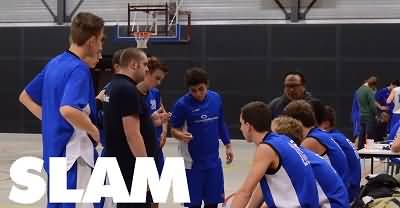
Looking at the diagrams 1-3, the offense is 4-out with one post player. The post player O5 can start at the free-throw line / high post (diagram 1), or at the left low block (diagram 2), or the right low block (diagram 3). Actions can be initiated in two ways, (1) by the point guard and perimeter players, or (2) by the post player.
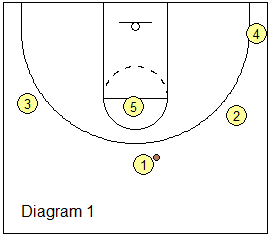
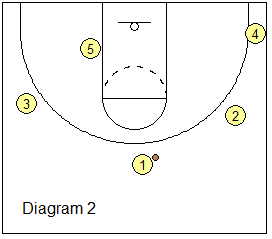
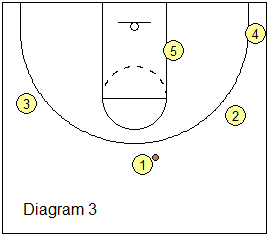
Option 1 - Slam initiated by perimeter player
Here the offensive actions are initiated by the perimeter players. The basic rule is that whenever a pass is made, the passer either cuts or screens after the pass, while the other players react to these actions, maintaining spacing.Screening options after passing:
- Screen-away (e.g. point screens for weakside wing).
- Up-screen or flare-screen (e.g. wing screens for point).
- Down-screen.
- Ball-screen (follow the pass and pick and roll).
- Hand-off (follow the pass and get hand-off).
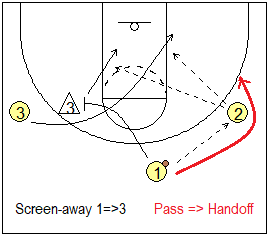
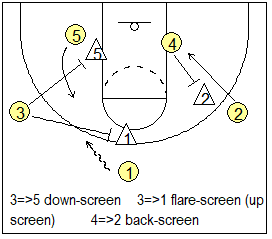
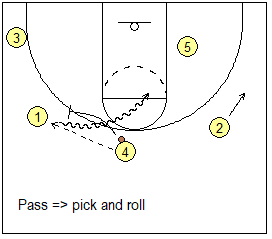
Cutting options after passing:
- Pass and basket cut / Give and go (diagram 11).
- Pass to the post and relocate on the 3-point line (e.g. slide to corner - diagram AK).
- Laker cut either over or under post player (diagram AK).
- Down-screen for the post and exchange.
- Dive and Replace (post exchange without screen). O1 passes to O3, cuts to the ballside left low block to post-up, while O5 (on the right block), cuts up to the top spot.
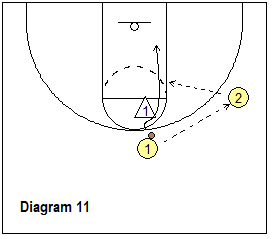
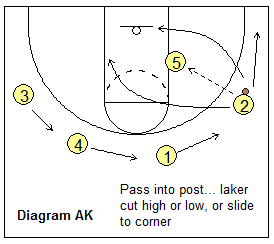
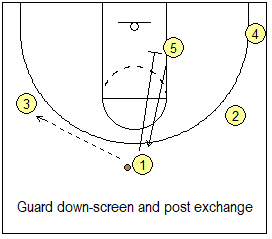
Option 2 - Slam initiated by post player
Here the actions are initiated by the post player. Every time the ball is passed on the perimeter, instead of the passer cutting or screening, the post player O5 takes the initiative and does one of the following things, while the other players react to O5's actions.Post player options after a pass:
- Back-screen (for a perimeter player).
- Ball-screen (pick and roll).
- Post-up (e.g pass to the wing).
- Flash cut to high post.
Options for perimeter players without the ball
Here are the things a perimeter player (who does not have the ball) can do when a pass is made.Spacing:
- Fill open spots.
- Relocate: Lift / drift.
A wing player may "lift" to the point guard spot after the point guard cuts through.
A player may "drift" down to an open wing or corner spot.
Cutting:
- Cut / Backdoor.
- Cut and fill (cut through and fill an open spot on the perimeter).
- Cut through (wrong way) and back-screen.
Example: player cuts through but cuts out to the wrong side where the perimeter spot is already filled. Here, he/she back-screens for that perimeter player, who then cuts through to the opposite side.
As you can see, the "Slam" motion offense is really nothing new, but simplifies things. I like the way the actions are initiated either by the perimeter players, or the post player - to mix things up a bit. This simple method would probably be a good way of teaching motion offense to young players.
Each of the individual options above must be explained and drilled so that it all makes sense to your players, and so that the cutting, screening and spacing actions become automatic. Players move to another level when they no longer have to think about what they're supposed to do, instead of thinking about how they are going to score.
Related pages:
- Motion Offense Principles
- Spacing and Movement - Moving Without the Ball
- Setting and Using Screens
- Drills for Teaching Motion Offense
- Motion Offense Screening Drills
- Post Player Breakdown Drills